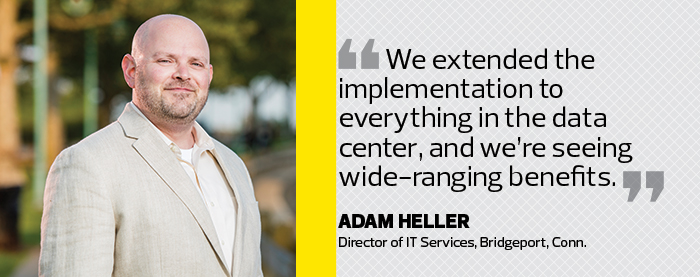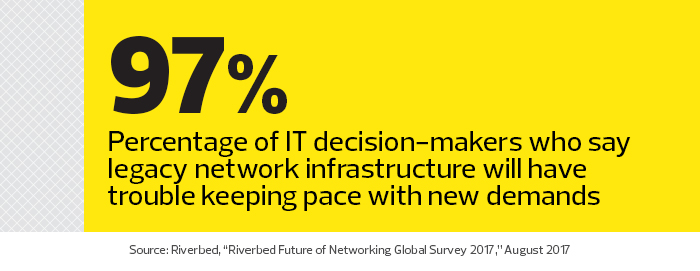How to Build a Stronger Business Case for State and City Tech Upgrades
The coastal municipality of Bridgeport, Conn., was concerned with flooding in some areas of the city when bad weather struck. To keep an eye on those areas remotely, it sought to install a video surveillance system. But city leaders quickly discovered that they lacked the network infrastructure to fully support video transmission.
“It just wasn’t going to happen with our current network infrastructure — before the upgrade was completed, we had to bypass some switches to get bandwidth we needed,” says Adam Heller, Bridgeport’s director of IT services. “In the funding discussion, I explained that better equipment was going to mean more information about vulnerable areas of the city. When you put it in business terms, people understand how the technology impacts their jobs, especially public safety.”
The city’s IT team previously maintained critical government and citizen services with existing technology, making upgrade proposals less urgent than other projects vying for funding, Heller says. That had to change to provide the 146,000 residents of the city with the new video surveillance system. So in 2017, after a decade of maintaining legacy network infrastructure, Bridgeport began installing new Brocade Ruckus switches.
Some jurisdictions may push the envelope for a major refresh, but waiting until there’s a compelling use case for new technology often makes more sense. Timing in making a business case often paves the way for successful technology upgrades across a state or local enterprise. Many find success when they focus on beneficial use cases rather than following those artificial refresh cycles.
Organizations should also develop criteria for what it means to fail, providing clear indications of when it’s time for an upgrade, says Andre Kindness, principal analyst at Forrester Research.

“Too many organizations feel pressured to upgrade because of an artificial perception of a five- to seven-year refresh cycle,” Kindness says. “There are good reasons to upgrade even if technology is working, such as the end of vendor support, which means no more patches or security fixes. But if that’s not what’s going on, a business case should drive the upgrade.”
“Clear guidelines can eliminate unnecessary refreshes as well as time spent making do with faltering technology,” he says.
SIGN UP: Get more news from the StateTech newsletter in your inbox every two weeks!
Modernized IT Offers Bridgeport New Benefits
Last year, Bridgeport also began implementing a new 911 dispatch system, and Heller was able to make the case that virtualizing the city’s data centers would provide the agility needed to make the emergency call system work. The resulting VMware vSphere with Operations Manager (vSOM) implementation reduced Bridgeport’s physical server footprint from 45 physical servers to 16 hosts, Heller says.
“We can now spin up servers at will without worrying about purchasing hardware, performance is improved, backups are better and easier, and we have more visibility into the environment,” Heller says. “The dispatch system gave a us a good reason to virtualize. We extended the implementation to everything in the data center, and we’re seeing wide-ranging benefits.”
Benefits from the new Ruckus switches won’t be fully realized until Bridgeport completes a planned move to a hybrid broadband arrangement with a new WAN service provider and a private fiber connection, Heller says; however, the new switches have already improved bandwidth on some of the most trouble-prone segments of the network.
Eau Claire Strategizes IT to Prepare for the Future
Eau Claire, Wis., belongs to an area networking consortium that plans to upgrade its shared 4G wireless network from WiMax to Long Term Evolution technology, but not soon enough to meet the city’s needs, says John LeBrun, IT manager for the municipality. The city completed the upgrade on its segment of the network on its own this spring.
“The LTE enhancements for frequency reuse and increased bandwidth were important considerations for new applications we wanted to deploy,” LeBrun says.
Other factors that prompted the project were also typical of those in most upgrade decisions, LeBrun says.
The city’s WiMax equipment was reaching the end of its useful life and, once the new LTE open standard was released, the manufacture of new WiMax equipment stopped. Eau Claire’s use of the wireless network was steadily expanding, and devices are now being manufactured for the new LTE standard. The cost of LTE components and compatible devices is dropping, LeBrun says.

To execute the project, the Eau Claire IT team updated and reconfigured the core network, swapped out WiMax tower equipment for LTE tower equipment, and learned the new management software. Mission-critical applications, such as those used in public safety vehicles, were upgraded to work with WiMax and LTE in advance of the LTE upgrade.
“As a new technology becomes available, it will be only a matter of time before it is something we will need to incorporate into our systems,” LeBrun says. “The upgrade to support the new technology needs to be in place before the user groups are ready to adopt it.”
Pressing upgrades should move up the priority list, but generally an update strategy should look ahead, LeBrun says.
“The expected evolution of technology needs to be considered,” he says. “What is done today needs to support the requirements of tomorrow.”
Successful IT Upgrades Focus on Stakeholders
The best business case demonstrates improved services and greater cost effectiveness for IT stakeholders. With that in mind, North Dakota continues to undertake innovative IT projects, says Duane Schell, the state’s director for network services.
“We have moved email to the cloud, along with some of our infrastructure services,” Schell says. “We are evaluating our entire technology stack, analyzing what the best source is for the services we offer and will offer in the future.”
The state’s IT managers are aggressively exploring cloud computing options for opportunities to be more agile and efficient and to align more closely with stakeholders’ needs, Schell says. In preparing to meet future IT requirements, the state maintains strong partnerships with technology manufacturers, such as HPE and IBM on the processing side, Extreme Networks and Juniper Networks for networking, and Palo Alto Networks for security. But it also has a heterogeneous computing environment built on finding technology that fits the job at hand, Schell says.
The decision about whether an infrastructure upgrade is needed comes down to a few questions: “Do we have concerns about support or capacity? Is it still cost-effective?
“Do we have the infrastructure in place to allow stakeholders to transform their business with technology and fulfill their missions in serving the citizens of the state?” Schell asks. “If the answer to any of those is ‘no,’ then it’s time for an upgrade.”








